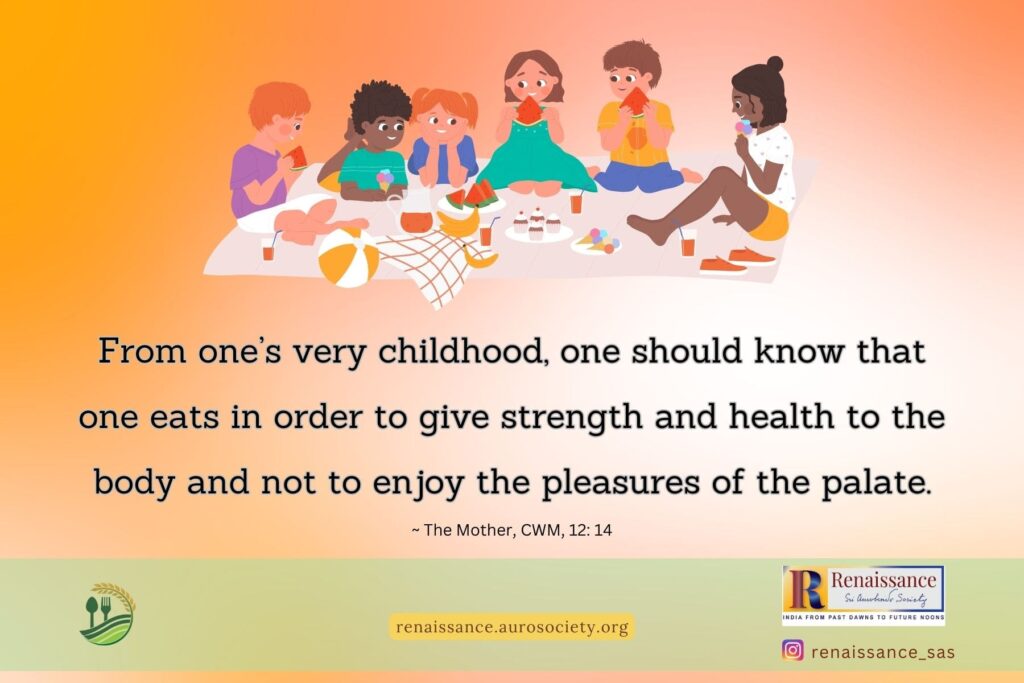Continued from Part 4
Editor’s note: In this part 5 of the series, the author reminds us that behind many of the customary practices and modes of conduct about which we hear from our elders, considerable knowledge and understanding of subtle truths of natural laws was there. But in its zeal for rationality, modern mind often brands these as ignorant superstitions or mere irrational convention which has no relevance today. We may recall here a letter of Sri Aurobindo in which he says that the word ‘superstition’ is “evidently an anachronism to apply it to beliefs not accepted by the form of religion one happens oneself to follow or favour.” Here is the relevant passage from the long letter:
It is quite true that the word “superstition” has been habitually used as a convenient club to beat down any belief that does not agree with the ideas of the materialistic reason, that is to say, of the physical mind dealing with the apparent law of physical process and seeing no farther. It has also been used to dismiss ideas and beliefs not in agreement with one’s own idea of what is the rational norm of supraphysical truths as well. For many ages man cherished beliefs that implied a force behind which acted on principles unknown to the physical mind and beyond the witness of the outward reason and the senses.
Science came in with a method of knowledge which extended the evidence of this outer field of consciousness and thought that by this method all existence would become explicable. It swept away at once without examination all the ancient beliefs as so many “superstitions”—true, half true or false, all went into the dust bin in one impartial sweep, because they did not rely on the method of physical Science and lay outside its data or were or seemed incompatible with its standpoint.Even in the field of supraphysical experience only so much was admitted as could give a mentally rational explanation of itself according to a certain range of ideas—all the rest, everything that seemed to demand an occult, mystic or below-the-surface origin to explain it, was put aside as so much superstition.
(CWSA, Vol. 28, pp. 388-389)
Popular beliefs that were the fruit sometimes of imagination but sometimes also of a traditional empirical knowledge or of a right instinct shared naturally the same fate. That all this was a hasty and illegitimate operation, itself based on the “superstition” of the all-sufficiency of the new method which really applies only to a limited field, is now becoming more and more evident. . . The growing reversal of opinion with regard to many things that were then condemned but are now coming into favour once more, is very striking.
If you have missed the previous parts, here are the links to access them – PART 1, PART 2, PART 3, PART 4.

When Śabdam Helps to Disperse Noxious Vāyu
Most of us have witnessed our elders asking those who are sneezing to leave the place during gatherings such as weddings or other auspicious functions. Did they do it because it was inauspicious to sneeze?
Certainly not! This is a health-related custom, which our ancestors had instituted in their wisdom as a part of the rituals. While sneezing, the condensed and impure air in the body gushes out – often accompanied by saliva, phlegm and microscopic bacteria that pollute the air. An explosive sneeze no doubt serves to get all the accumulated toxic air and impurities out of the air passages including the nose, but it also scatters germs and bacteria in the process.
Today the corona-virus-related advisories ask us not only to stay away from those who sneeze and cough, but also maintain suitable distance from anyone while outside the house to avoid droplets from their saliva, phlegm or mucus fall on you, just in case someone is a carrier of the virus. Seen in this context, don’t our ancestors come across as being much more scientifically aware than anyone gives them credit for? Their so-called taboos were, in fact, rooted in sound common sense connected with health.

But there is something more beyond the mere hygienic aspects of sneezing away from people. Let us examine how śabdam and vāyu (sound and air) work together to maintain a healthy balance of the elements in our body.
Let me begin by painting a scene which is not too uncommon.
The evening pūja is going on in a crowded temple. Arun stands in front of the garbhagriha with folded hands. He looks as if he is lost in the contemplation of the Deity, but is in fact thinking about his assessment report that he received that afternoon – the report was not too good.
A few feet away from him sits old Guptaji, leaning on a pillar. His eyes are closed as if in meditation, but perhaps he is taking a nap. In the crowd of devotees is also Usha, who has come to the temple with her mother. She is bored and wants the ārati to start, so that they could leave. She tries concentrating on the pūja, and unknowingly yawns. Guiltily she looks around and sees many around her yawning away. She wonders curiously as to who started the chain of yawns!
Suddenly the temple bells begin clanging as the ārati starts. Instantly, Arun, Guptaji, Usha and all the yawning devotees are alert and begin clapping to the beat of the ārati.
Do you know that we just witnessed – the amazing power of sound or śabdam – one of the panćēndriyās, coming to the rescue of the polluted mind and awakening the mind and body. I have mentioned the yawning devotees because sound also helps with controlling the yawning habit. Our elders had a very simple solution using śabdam, to deal with the yawn. But we will come to that later.
Let us first look at some basic facts about respiration. It is important to breathe through our nostrils as they have inbuilt fine filters in the form of very fine hairs which filter the air we breathe in of noxious gases and particulate matter, allowing more oxygen into the windpipe. The amount of oxygen we inhale determines our good health.

Have you noticed that we often breathe through our mouth instead of the nostrils? For example, whenever we are talking incessantly on our cell phones, or are engrossed in some apps on our smartphones, or are immersed in some serious work such as reading, writing, thinking or listening intently as during a lecture. We even unknowingly hold our breath while watching something thrilling on the screen or in real life, exhaling only when it ends.
All these factors interfere with the inhalation-exhalation process. When we talk, we don’t breathe through the nostrils, but only through the mouth, thereby allowing unfiltered air to enter the system along with carbon-dioxide and other gases. Likewise, when we are engrossed in some serious activity, we never inhale normally through the nostrils, or just do shallow breathing. And when we hold our breath, we don’t inhale at all, thereby increasing the quantity of impure vāyu in the respiratory track and lungs.
Now visualise this: our lungs are filled with impure blood, waiting for oxygen, but we are not inhaling normally, thereby not sending in enough fresh oxygen to purify the blood. Since only oxygenated blood can pass through the arteries to the heart, the blood becomes dense and the breathing becomes heavy.
But Nature has a wonderful tool in the form of yawning to remove the noxious gases that have accumulated in our body due to our incorrect breathing.
Have you ever wondered why it seems to be contagious, especially in a room with lots of people, just as we saw it happen in the crowded temple?
When one yawns without trying to close the mouth or suppress it in anyway, the heavily laden foul breath escapes in a large quantity, sometimes accompanied by a loud sound let out by the person yawning. If a person near the one who is yawning inhales this impure air unknowingly, it enters that person’s lungs and soon he or she is yawning too. Before long there is a chain of yawns.

In Tamil, there is a saying – ‘A kumari (young girl) might go alone on a lonely road, but a kottaavi (yawn) will never go alone.’ In this saying, the original word was kottaan (ghost), which later got corrupted to kottaavi. It means that even a young girl would go alone but the ghost never would, it always takes others along. By the ghost, our elders had meant the impure air exhaled through the yawn. What does this ‘ghost’ take along? Yes, it takes the toxic air exhaled by others too!
Modern day etiquette dictates that it is impolite to yawn with an open mouth, but that is the best way to get all the foul air out of the lungs – better still, to let out a sound along with a yawn helps even more! When the yawn is suppressed, the foul air remains in the system making one even more tired.
This brings me to the use of śabdam which our elders used to recommend to deal with open-mouthed yawns.
The customary practice was to open one’s mouth wide when yawning and also to let out a sound. Simultaneously, one would snap one’s fingers or clap with one’s hands in front of the open mouth. It is significant to mention here that the thumb and middle finger represent agni and ākāśa respectively. The sound from the throat, the fingers or hand – all helped to disperse half the polluted air that escapes in a gust.
Let us recall the story of the boys who had run away from the tamarind tree, which I had written about in an earlier article. There too, it was their screams which helped them move, by eliminating the noxious air they had inhaled and removing their tiredness.
We have seen how accumulated toxic air in the lungs is cleared by yawning accompanied by sound. There are other methods used by Nature to rid the body of accumulated foul air – sneeze and hiccough. Let us look at the sneeze and the role of śabdam in sneezing.
It is customary for elders to say, ‘Hari Om!’ or ‘Shiva!’ when either they themselves or others sneeze, repeating it after every sneeze. Their sneeze would also be explosive with a loud hachchoo! Would you believe me if I said that this is the best way to sneeze as it clears the air passages and lungs effectively? (Śabdam to the rescue again!) Often people close their mouths while sneezing, or pinch their nose to stop an impending sneeze. Such actions can cause many health disorders, including allergies, breathing difficulties such as asthma, ear-related problems, chronic and even incurable diseases.
Haven’t we heard of the beautiful story from Srimad Bhagvatam about Hanuman snapping fingers for Sri Rama’s yawn? Read the story HERE.
It is important to recall that our elders never admonished one to stop a sneeze, or told us to sneeze soundlessly. Instead, one was encouraged to sneeze aloud. But this is possible only when one is alone. Then one could sneeze aloud and not worry about dislodging germs and bacteria in the air that might harm others in the vicinity. But when surrounded by people, one was always supposed to be mindful and leave the gathering if one wanted to sneeze.
Thus, both the yawn and sneeze are accompanied by sound, since sound disperses air. The added sound made with the hands and fingers helps to disperse the foul air of a yawn. Thus we understand that the bhūtas and índriyas work together to keep us healthy. In this case the índriya of śabdam comes to the aid of two bhūtas – vayu (yawn), and vāyu + āpas (sneeze). We will examine more of this relationship in the future articles.
To be continued. . .
Read Part 1, Part 2, Part 3, Part 4

~ Design: Beloo Mehra
~ Cover image: Rishabh Sharma



